Motion sensor connections to turn on the light
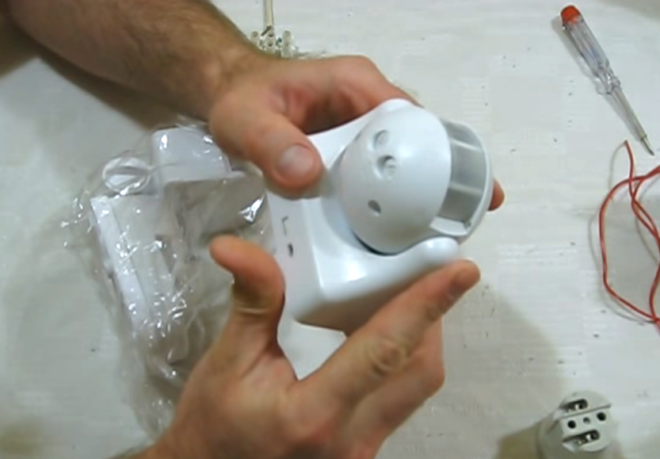
Did you know that initially the connection of a searchlight with a motion sensor was conceived solely for security purposes? When unwanted guests entered a warehouse or parking lot at night, such a device triggered the movement, as a result of which the light was turned on. This gave a sign to the watchman or frightened off the "guests". However, later, someone came up with a great idea - why not use this device for peaceful purposes? Since then, in many public and residential places, a motion sensor has been found to turn on the light. The scheme for connecting it to the general electrical network is not different in complexity; even an electrician without many years of experience and experience can cope with this.
Content
Where and when is it applied?
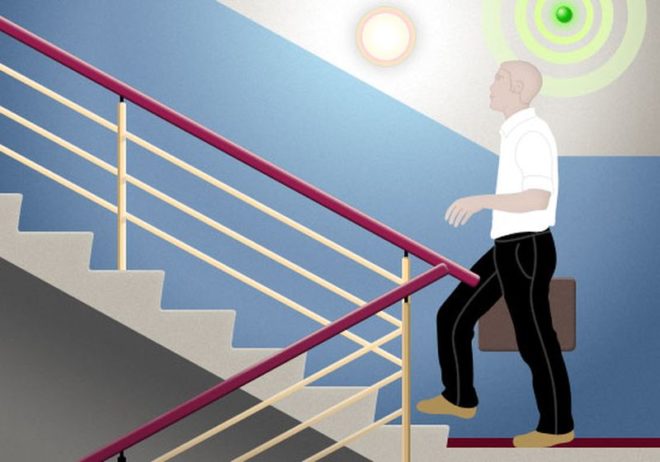
A switch with a motion sensor is very convenient when an object enters an unfamiliar, unlit place. He won't have to fumble around the walls in the dark trying to find the switch and turn on the lights. As soon as a person appears in the doorway, the lamp will turn on.
 The connection diagram of the motion sensor for lighting is often used in the following cases:
The connection diagram of the motion sensor for lighting is often used in the following cases:
- At the entrance to the entrances of apartment buildings.
- In passages and staircases, which have natural light during the day, and require additional lighting in the dark.
- On the stairs leading to the basements.
- In garages, storerooms, basements and other outbuildings and rooms that are not naturally lit.
- On walk-through staircases and in corridors that are located inside the building and do not have natural light during the day.
- In bathrooms (in this case, a switch with a motion sensor is more necessary to turn off the light, because, as a rule, leaving the bathroom, especially in public places, many people forget and do not turn off the lighting).
If there is such a need, you can install a motion sensor and configure it at the same time to turn on the lamp and some household appliances (for example, a TV, an exhaust fan in the bathroom, an air conditioner).
Classification
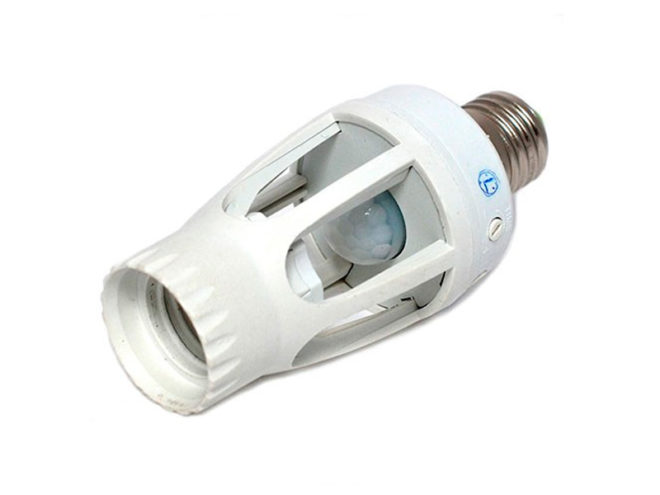
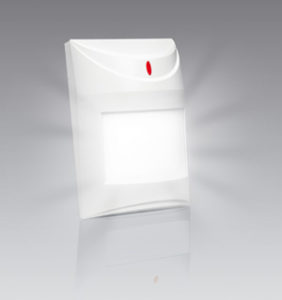
Before connecting a motion sensor, find out what this device is like and what the principle of its operation is based on.
These devices are classified according to several parameters. For example, at the place of installation, they are perimetric (mounted for street lighting), peripheral and internal. Motion sensors, which are designed for outdoor installation, can withstand high and low temperatures and humidity.
By triggering method:
- Thermal. Such devices react to changes in the temperature regime in the area under their control.
- Oscillatory. Here, the reaction is already going to a change in the magnetic field or the external environment when the object moves.
- Sound. It is triggered by an impulse from air vibrations when sounds appear.
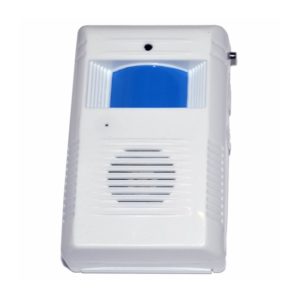
By installation method:
- Ceiling (should be installed in suspended ceilings).
- Overhead (wall mounted).
Ceiling and wall units have different viewing angles.Ceiling-mounted ones cover 360 degrees of space, while wall-mounted ones span from 90 to 240 degrees.
Structurally, the devices are external (mounted on special brackets) and built-in (mounted in boxes for switches or in special holes in the ceiling next to the place where the chandelier is attached).
Sometimes these devices are made in such a way that they look very much like a regular light fixture. A light switch is often combined with a motion sensor, which is very convenient, because in this case several functions are performed at once.
How does an infrared device work?
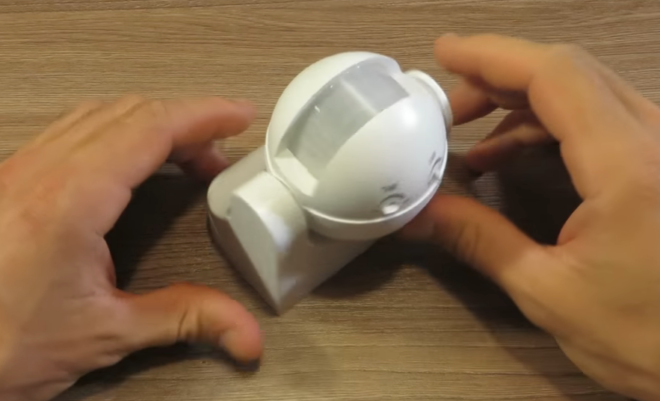
An infrared motion control device is also called passive. If you compare roughly, you can associate it with a thermometer. It is triggered when a heat source enters its range.
But for such a device to work, additional settings are required. For example, you set up such an infrared device and set it up for the appearance of an adult. If a child enters the room, the sensor may not work. The body temperature is the same for everyone, but the amount of heat that an adult and a child study is different. In this case, setting the device to the very minimum is also not a way out of the situation, it will then begin to react to any cat or dog running into the room. This is the disadvantage of infrared models - they require careful manual tuning. Another disadvantage of this sensor is that it falsely triggers on heating devices operating in the room.
But such a sensor also has a number of advantages:
- First, it does not emit anything that would harm the human body.
- Secondly, at the price it is available to a wide consumer circle.
- Infrared devices have additional controls. Not only the response threshold, but also the angle of the coverage can be changed.
- The device is suitable for indoor and outdoor use.
Learn more about the infrared sensor in this video:
Features of the ultrasonic device
An ultrasonic device is classified as an active device. Its principle of operation is based on high-frequency signals that are reflected from an object in the field of view. We can say that the sensor "memorizes" a certain picture. As soon as it starts to change (a new object appears or an old one starts to move), it is triggered. At a given time interval, the ultrasonic sensor sends signals, they are reflected, and the device analyzes them.
Such a motion sensor instead of a switch is not often used, despite its excellent reliability. The whole question is in a very high price, an ultrasonic device costs several times more than an infrared one. Most often it is used for security systems.
There are a couple more disadvantages to this model. Firstly, pets can hear ultrasound perfectly. Secondly, such a device works for sudden movements, if the object moves slowly, the sensor may not react.
How the microwave sensor works
The microwave sensor is also considered an active device. It has a similar principle of operation with an ultrasonic control device, waves are also emitted, then reflected and received back. The only difference is the use of electromagnetic waves, not sound waves.
These are the most versatile of all such devices. The area allocated for their control is constantly scanned, any movement will be noticed, a signal to light or the launch of other devices will certainly work. The waves reach absolutely all objects that are in the area of effect and are reflected. If the objects are not moving, then the waves return with the same frequency. If any movement is detected, then the frequency of the wave is shifted and the sensor is triggered.
Like any other device, the microwave sensor has its drawbacks:
- high price;
- the device is too sensitive, therefore it sometimes works falsely;
- such rays adversely affect human health, so it is not advisable to stay in the range of this device for a long time.
You can learn more about the device of motion sensors in this video:
Connection diagram options
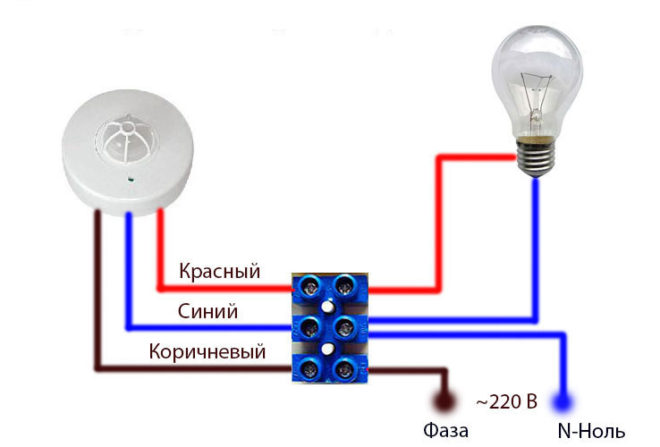
The device controlling the movement can be two- or three-pole. For the first option, only an incandescent lamp is suitable; this sensor must be connected in series with the lamp. Of course, the three-pole model is universal; such a device is connected with different lamps.
There are two options for the scheme: connecting the motion sensor through a conventional switch or directly to the lamp.
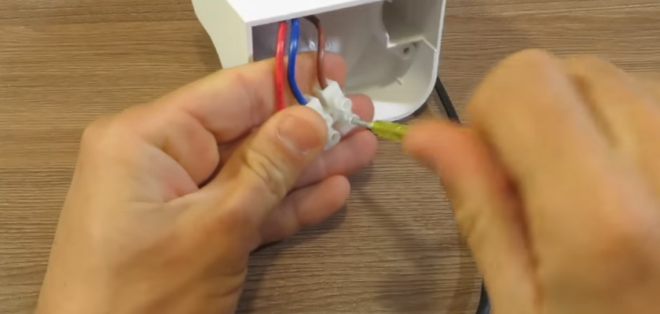
So, first let's look at a motion sensor to turn on the light closer. Its connection diagram will be standard - one device in an ordinary electrical circuit. Such a sensor has three terminal clamps (sometimes four, one more for connecting the protective ground). They all have their own designations:
- One terminal is connected to the phase wire of the supply network, it is marked on the device with the letter "L".
- The neutral wire is connected to the second, its designation is the letter "N".
- And the third clamp is connected by a separate wire to the load (lighting fixture). Different models use a different designation for this terminal block - the letter "L" with an arrow, the letter "A" or just an arrow.
- If there is a clamp for protective earthing, then it is designated by two letters "PE".
When using such a scheme, it is convenient to focus on the color coding of the sensors: lilac means the incoming phase, blue (or blue) means zero, red means the wire going out to the lamp holder.
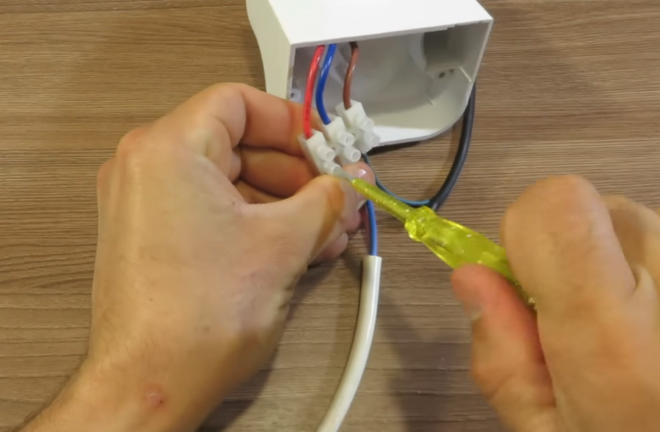
In this case, it is very important not to confuse phase and zero, as in a conventional switch. The circuit will work, but a phase will be present on the luminaire, even in the off position, which is dangerous if it gets energized when replacing the lamps.
If it is necessary that at some moments the light in the room was constantly present, without a reaction to the movement of objects, the connection of a motion sensor for lighting in parallel with the switch is used. When the switch is in the off position, the light is controlled through the sensor. If the switch is in the "on" position, power is supplied to the lamp through a different chain, bypassing the sensor. Most often, this option is used in living rooms.
There are situations when one sensor cannot cover the entire area of the room (for example, corridors with turns). With such a complex configuration, several sensors will be needed to monitor different areas, they are connected in parallel. Their actions in this case are duplicate, the light will turn on for any movement in each of the controlled areas.
If the lighting load in terms of its total power is higher than that provided for by the technical characteristics of the sensor, then a circuit using an intermediate power relay (magnetic starter) is used. In this situation, the sensor does not directly control the lighting fixture. Voltage is applied to the starter coil, and its power contacts close the circuit, and then the lamp lights up. This scheme is good not only because a large load is connected. If an overload or short circuit occurs in the network, this can lead to melting or burning of the sensor contacts, and such an expensive device will need to be replaced. In the case of using the scheme in question, the relay (or starter) will fail, which cost much less.
For details on connecting the sensor, see this video:
Settings and location selection
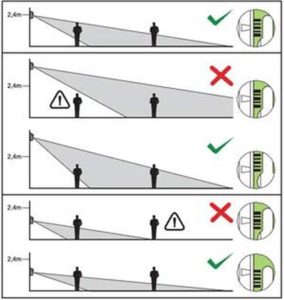 When installing sensors indoors, observe the following rules:
When installing sensors indoors, observe the following rules:
- It is impossible for them to be directly exposed to light from the lamps.
- In the zone of their influence, the presence of glass partitions or bulky objects that will obstruct the view are not allowed.
- If the room is very large, then it is advisable to mount ceiling sensors so that the affected area is circular.
- Heating systems or air conditioners should not interfere with the operation of sensors in order to minimize false triggering of devices from warm air currents.
There are special models that do not react to the movement of objects not exceeding 40 kg in mass (this is indicated in the passports for the sensors). If pets live with you in the house, it is better to immediately opt for such options.
When installing the device in open street spaces, there are some nuances:
- The connected device must be protected from direct sunlight during the day.
- No shrubs or trees are allowed between the device and the affected area. Again, in the case of a complex site configuration, several sensors will be needed.
- Also, make sure that your device is not exposed to light from nearby areas or street lights.
- It is very important to choose the right sensitivity of the device. It must completely cover the control area, but not grab the territory behind it, otherwise it will react to any person passing by.
- Be sure to regularly wipe the sensor lens, always keep it clean, otherwise a layer of dust accumulating over time may lead to a decrease in the sensitivity of the device.
The sensor settings are made by three rotary levers located on the body. One of them is responsible for the time after which the lamp turns off, the second for the illumination threshold and the third for the sensitivity.
The following video describes how to set up a motion sensor to work with a spotlight:
When choosing a motion sensor, pay attention to its following technical parameters: range, installation method, detection angle in the horizontal and vertical planes, degree of protection against environmental influences, load power, light level response threshold and the ability to adjust the time delay before shutdown ...



